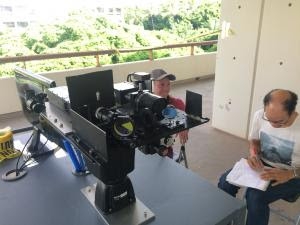By Staff Reports
(Hawaii)– Researchers at the University of Hawai‘i at Mānoa (UHM) School of Ocean and Earth Science and Technology (SOEST), in collaboration with NASA, have developed an innovative new spectroscopy instrument to aid the search for extraterrestrial life. The new instrument is designed to detect compounds and minerals associated with biological activity more quickly and with greater sensitivity than previous instruments.
Shiv Sharma and Anupam Misra, researchers at the Hawai‘i Institute for Geophysics and Planetology (HIGP) in SOEST, and team developed the new instrument, which improves on an analytical technique known as micro-Raman spectroscopy. This technique uses the interaction between laser light and a sample to provide chemical composition information on a microscopic scale. It can detect organic compounds such as the amino acids found in living things and identify minerals formed by biochemical processes on Earth that might indicate life on other planets.
“Our instrument is one of the most advanced Raman spectrometers ever developed,” said M. Nurul Abedin of NASA Langley Research Center, who led the research team. “It overcomes some of the key limitations of traditional micro-Raman instruments and is designed to serve as an ideal instrument for future missions that use rovers or landers to explore the surface of Mars or Jupiter’s icy Europa moon.”
The researchers report that their new system, which they call the standoff ultra-compact micro-Raman (SUCR) instrument, is the first to perform micro-Raman analysis of samples four inches away from the instrument with 17.3-micron resolution—finer than a human hair. The new spectrometer is significantly faster than other micro-Raman instruments and extremely compact. These features are important for space applications and could also make the instrument useful for real-time biomedical and food analyses.
“Micro-Raman spectroscopy is being explored for detecting skin cancer without a biopsy and can be used to for food analysis applications such as measuring caffeine in drinks,” said Abedin. “Our system could be used for these applications and others to provide fast chemical analysis that doesn’t require sending samples off to a laboratory.”
Designing for space
For space exploration, the instrument had to be small and light to minimize fuel use during the nine-month journey to Mars or the six-year journey to Europa; but also robust enough to withstand the harsh conditions in space.
The SUCR instrument uses the direct coupled Raman system design previously developed at UHM by Sharma, Anupam and others for remote chemical detection of samples over 100 meters away from the instrument in daylight. To create the SUCR instrument, the researchers modified the collection optics of the previously developed system to acquire spectra of samples closer to the instrument. They also further reduced system’s footprint by using a miniaturized spectrometer—small enough to carry with one hand.
The compact instrument connects all the optics directly to the spectrometer, which significantly improved performance compared to fiber-coupled Raman systems because less signal is lost.
Fast analysis in daylight conditions
The new instrument offers several important improvements to previous micro-Raman spectroscopy instruments, which require samples to be collected prior to analysis and measurements to take place in the dark. The team carefully designed the optics of the system to enable fast analysis under daylight conditions and to produce a strong Raman signal that isn’t as prone to interference as traditional systems.
In room light on conditions, they used SUCR to analyze minerals and organic compounds that might be associated with life on other planets, including included sulfur, naphthalene, mixed samples, marble, water, calcite minerals and amino acids.
Because of the speed of the system, the team is hoping to create a Raman map of an area 5 by 5 millimeters in only one minute. Doing this with a traditional micro-Raman system would take several days.
As a next step, the researchers plan to test their SUCR instrument in environments that mimic those found on Mars and other planets. They will then begin the validation process to show that the device would operate accurately under conditions found in space.
From the Optical Society press release.

